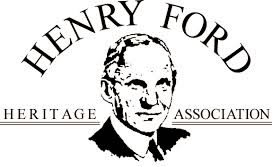The Birth of Ford Motor Company
The Birth of Ford Motor Company
This article first appeared in the Dearborn Historical Museum’s Dearborn Historian newsletter in early 2003 (the year of the centennial of the founding of Ford Motor Company). It was then reprinted in the Henry Ford Heritage Association’s Summer 2003 issue of The Ford Legend newsletter.
1863Henry Ford was Born on July 30th
Henry Ford was born on July 30, 1863, and grew up on his family's prosperous farm in Springwells Township about seven miles due west of Detroit. He attended school through the sixth grade and in 1879 at age sixteen, without his father's consent, walked into Detroit and obtained work at the Michigan Car Company Works where streetcars were built. Henry's father then arranged for Henry to become an apprentice machinist at the James Flower & Brothers Machine Shop. In 1881, Ford was working for the Detroit Dry Dock Company where he learned a great deal about heavy industry. By 1882 he was back on the farm operating a small steam traction engine for a neighboring farmer, and soon after repairing such engines built by the Westinghouse Company.1888 Ford marries Clara Bryant
While home on the farm Henry Ford met Clara Bryant and the two were married on April 11, 1888. They set up housekeeping on an 80-acre farm given to Henry by his father.1888 Henry Ford accepts a position with Edison Power Plant
Henry, however, had no intentions of farming the land as his father would have expected. Instead, Henry spent the next two years using a steam engine to cut wood off his land and that of his neighbors. After having built a "honeymoon" cottage on their farm, it was rather shocking to Clara to find Henry, in September 1891, wanting to move to Detroit to accept a $40 a month position as night operating engineer at a substation of the Edison Illuminating Company. The position at Edison appealed to Henry because he would be learning electrical engineering. By October of 1892, Henry was called upon to take charge of maintenance of steam engines in the main downtown Edison Illuminating Power Plant at $75 per month.1893
Ford was intrigued with gasoline engines. His first simple and crude engine was operating by December 1893, on the kitchen sink of the Ford's rented Bagley Avenue home. On Christmas Eve 1893, with Clara dripping in the fuel, Henry ran the little engine for less than a minute. Thus, Henry had now determined the principles of the gasoline engine.1896the "Quadricycle"
Henry's maintenance position at Edison now allowed him a great deal of time to experiment in building a variety of gasoline engines. With help from his friends Ford experimented with various engine designs. In considerable secrecy, his first vehicle, the "Quadricycle", was assembled in June of 1896 in the woodshed behind #58 Bagley Avenue.1896

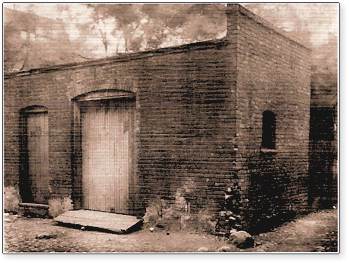
The woodshed at 58 Bagley in which Henry Ford assembled the "Quadricycle" in June of 1896, and then had to widen the door it get the rig out of the building.
189960 mile demonstration ride, July of 1899
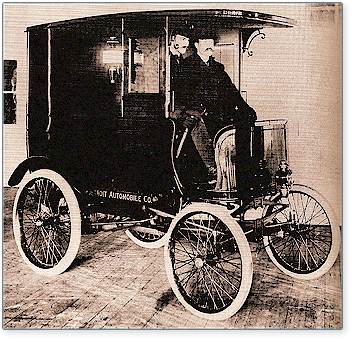 During that same summer, Henry was invited by his boss, Alexander Dow, to attend a meeting of Edison Illuminating Company executives at Manhattan Beach in New York. At the meeting Ford had an opportunity to discuss his gasoline automobile with Thomas Edison. Surprisingly, Edison, who usually advocated electric vehicles, told Ford that with his gasoline engine he was headed in the right direction. Edison's remarks were a tremendous stimulant to Ford. Dow, however, a strong advocate of electricity for motive power, wanted no hazardous gasoline on his property. While still employed by Edison and working on an improved vehicle, Ford began thinking seriously of manufacturing gasoline automobiles. A second Ford vehicle was completed in 1898. Ford found he needed considerable financial help if he were to go into the business of building automobiles. Henry's friend, [Detroit] Mayor William C. Maybury, introduced Henry to many of the notables in Detroit. In July of 1899, Ford had an opportunity to drive wealthy Detroit lumber merchant William H. Murphy on a 3-1/2 hour, 60 mile demonstration ride to Farmington, Pontiac and back to Detroit thus gaining his first strong financial backer.
During that same summer, Henry was invited by his boss, Alexander Dow, to attend a meeting of Edison Illuminating Company executives at Manhattan Beach in New York. At the meeting Ford had an opportunity to discuss his gasoline automobile with Thomas Edison. Surprisingly, Edison, who usually advocated electric vehicles, told Ford that with his gasoline engine he was headed in the right direction. Edison's remarks were a tremendous stimulant to Ford. Dow, however, a strong advocate of electricity for motive power, wanted no hazardous gasoline on his property. While still employed by Edison and working on an improved vehicle, Ford began thinking seriously of manufacturing gasoline automobiles. A second Ford vehicle was completed in 1898. Ford found he needed considerable financial help if he were to go into the business of building automobiles. Henry's friend, [Detroit] Mayor William C. Maybury, introduced Henry to many of the notables in Detroit. In July of 1899, Ford had an opportunity to drive wealthy Detroit lumber merchant William H. Murphy on a 3-1/2 hour, 60 mile demonstration ride to Farmington, Pontiac and back to Detroit thus gaining his first strong financial backer.1899Detroit Automobile Company was founded on August 5, 1899
Funded by Murphy and several of his friends, and with Henry Ford in the position of Superintendent, (receiving a salary of $150 a month) the Detroit Automobile Company was founded on August 5, 1899. The manufacturing plant was to be at 1343 Cass Avenue at Amsterdam in Detroit. On August 15, 1899, Henry Ford resigned from the Edison Illuminating Company, turning down a promised salary of $1900 a year. The first product of the Detroit Automobile Company, a delivery wagon, was completed in January 1900, and demonstrated on the streets of Detroit with considerable success. Major stockholders, however, were pushing for a variety of vehicles and were in a hurry to make profits while Henry was beset by a number of engineering problems. His experience had not included making more than one car at a time. Several cars were produced but not at the quality Ford would have liked and at a price too expensive to sell. Henry received what appears to have been his final check for $75 on October 29,1900. The Detroit Automobile Company was officially dissolved in January 1901. While Henry was with the Detroit Automobile Company, he received a letter from his friend Oliver Barthel, an attorney and draftsman, warning of the Selden patent, a legality with which Henry Ford would soon have to contend.1901 The "Sweepstakes " racer of 1901, with Henry Ford at the wheel and Ed Huff on running board
 Henry Ford still had friends in Detroit. Some of the former stockholders of the Detroit Automobile Company retained a portion of the Cass Avenue plant so Henry could build a car of his choice. Ford had been thinking of a racer. His specialty was engines and he was convinced that racing would attract the attention necessary to establish himself in the automotive field. With part-time help from his friends, Ed (Spider) Huff, Oliver Barthel, and C. Harold Wills, he worked around the clock. A lightweight 2-cylinder racer of 26 horsepower was finished in mid-1901. This vehicle is said to have cost about $5000 to build, with much of the cost again covered by Murphy. Ford drove the racer at the Grosse Pointe equestrian track on October 10, 1901, besting Alexander Winton's 40-horsepower machine in a ten-mile race. Ed Huff hung on to a running board, balancing the car on the curves, as speeds reached close to a mile a minute. Ford received a $1000, a cut-glass punch bowl, and much publicity for his victory.
Henry Ford still had friends in Detroit. Some of the former stockholders of the Detroit Automobile Company retained a portion of the Cass Avenue plant so Henry could build a car of his choice. Ford had been thinking of a racer. His specialty was engines and he was convinced that racing would attract the attention necessary to establish himself in the automotive field. With part-time help from his friends, Ed (Spider) Huff, Oliver Barthel, and C. Harold Wills, he worked around the clock. A lightweight 2-cylinder racer of 26 horsepower was finished in mid-1901. This vehicle is said to have cost about $5000 to build, with much of the cost again covered by Murphy. Ford drove the racer at the Grosse Pointe equestrian track on October 10, 1901, besting Alexander Winton's 40-horsepower machine in a ten-mile race. Ed Huff hung on to a running board, balancing the car on the curves, as speeds reached close to a mile a minute. Ford received a $1000, a cut-glass punch bowl, and much publicity for his victory.1901 Henry Ford Company is formed on November 30, 1901

With Ford's much enhanced reputation, Murphy and the other members of the Detroit Automobile Company formed the Henry Ford Company on November 30, 1901. Ford was named Chief Engineer with one-sixth of the company stock valued at $100,000. The goal was to build a lightweight runabout to sell for about $1000. But Henry, with "racing fever," spent most of his time on the design of a giant 4-cylinder racing car. Although Murphy had financed the 2-cylinder racer, he did not want Ford working on a larger car. To Ford's annoyance, a wearied Murphy brought in Henry M. Leland, a well respected mechanical engineer, as a consultant.
By March 3, 1902, Tom Cooper, a wealthy and well known champion bicyclist, was in touch with Ford (Cooper and Barney Oldfield had put on an exhibition bicycle race on the day of the Ford - Winton race). Cooper wanted Ford to build him a racer and soon agreed to fund the construction of not one but two cars. On March 10, Ford left the Henry Ford Company with an agreement giving him the use his name, $900 and the drawings for the big racer (Oliver Barthel maintains that he prepared the layout drawings for the racer, with C. Harold Wills making the detailed drawings). With Ford gone, Murphy and backers took charge at the Henry Ford Company. With Leland on board, they quickly reorganizing under a new name, the Cadillac Automobile Company.
1902 The Monstrous Ford Racer

In May of 1902, Ford and Cooper arranged for shop space at 81 Park Place in downtown Detroit. The major focus was the building of the two racers, the "999" for Ford and the "Arrow" for Cooper. Both racers were named after two fast railroad express trains of the time. In the shop there were about ten employees working ten hours a day for ten cents an hour. The first race they had in mind was the Manufacturers' Challenge Cup to be held at Grosse Pointe on October 25, 1902. Working on the cars were Ford and his chief helpers, C. Harold Wills, Ed Huff and Gus Degener. When the "999," was ready to test, Ford, Cooper and Huff tried the racer but none was willing to drive it in a race. The car developed somewhere between 80 and 100 horsepower! Cooper got his friend Barney Oldfield to learn- to drive the "999", a task he accomplished within one week. Barney won the race and Ford's name was bigger than ever.
1902 Alexander V. Malcomson joins henry Ford in the automobile business
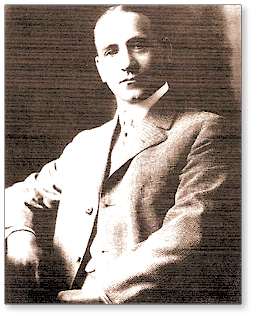
Even before the race in October 1902, Henry had been in touch with Alexander Malcomson, a well-known Detroit coal dealer, in regard to marketing a motor car of simple design. Wills had made drawings of such a vehicle, and a partnership of Ford & Malcomson was arranged to continue work at 81 Park Place. Based on a "Memorandum of Agreement" dated August 20, 1902, details of the partnership were signed by Malcomson and Ford with C. Harold Wills as a witness. Under the agreement, Wills was to receive a wage of $125 a month to be split 50/50 with Ford. In essence, Ford was working as an employee of Malcomson who was paying the bills. In November 1902, the partnership took the name of Ford & Malcomson Company, Ltd. and was capitalized at $150,000 with 15,000 shares at a par value of $10.00 each. A lightweight automobile, which Malcomson was inclined to call the "Fordmobile," was designed and built before Christmas.
Plans to move operations to a larger building on Mack Avenue, leased by Malcomson for $75 a month, were made in January 1903. The move to the new plant took place on May 1, of the same year. On February 28, 1903, Ford and Malcomson, "doing business as the Ford Motor Company," bravely entered into a costly and detailed "Memorandum of Agreement" with John F. Dodge and Horace E. Dodge involving the purchase of 650 automotive running gears at $250 each, totaling a cost of $162,500. Other smaller purchases were at the same time being arranged with other suppliers for car bodies, wheels, and tires. As early as March 25, 1903, for example, 300 sets of automobile wheels were ordered from the W. K. Prudden Company of Lansing, Michigan, to be delivered during the period of April to July 1903. In May of 1903, 100 Runabout bodies at $23 each, and 50 Tonneaus at $24 each, were ordered from the C.R. Carriage Company of Detroit. Tires were purchased from the Hartford Rubber Company at $40 per set of four.
1903

By March 15, 1903, however, Ford and Malcomson were already in trouble when the Dodge Brothers insisted on payment of $5,000 for their first shipment of automobile parts. Sales of stock in the company had been slow; many of the stocks had been purchased by notes, so there were insufficient funds to handle initial expenses. In such crises Malcomson depended on his wealthy uncle John S. Gray for help. Gray was president of Detroit's German-American Bank and often made risky loans to Malcomson. Gray was willing to receive 105 shares and to be president of the company (during the period Gray was President, Henry Ford was vice president).
One of the prospective stockholders, John W. Anderson, a Detroit lawyer, working for Malcomson, was especially enthusiastic about investing with Ford and Malcomson. In a long letter dated June 4, 1903, to his father, a physician in La Crosse, Wisconsin, Anderson described the plans of the new company in elaborate detail. Apparently his father loaned him $5,000 with which he bought Ford stock on June 27, 1903.
1903
 During a meeting on June 15, 1903, at the suggestion of Malcomson, the company name was to be officially "Ford Motor Company". "Articles of Association" were filed on June 16, 1903. On June 18, Ford & Malcomson, with assets valued at $51,000, transferred all their holdings to Ford Motor Company in exchange for 510 shares of Ford Motor Company stock divided equally between Ford and Malcomson. At that time there were twelve stockholders owning Ford Motor Company: Ford and Malcomson holding 255 shares each, Gray 105 shares, eight others each with 50 shares, and James Couzens with 25 shares. James Couzens was Malcomson's coal office clerk. C. Harold Wills, held no shares but was to receive one-tenth of Ford's profits which would have been equivalent to about 25 shares.
During a meeting on June 15, 1903, at the suggestion of Malcomson, the company name was to be officially "Ford Motor Company". "Articles of Association" were filed on June 16, 1903. On June 18, Ford & Malcomson, with assets valued at $51,000, transferred all their holdings to Ford Motor Company in exchange for 510 shares of Ford Motor Company stock divided equally between Ford and Malcomson. At that time there were twelve stockholders owning Ford Motor Company: Ford and Malcomson holding 255 shares each, Gray 105 shares, eight others each with 50 shares, and James Couzens with 25 shares. James Couzens was Malcomson's coal office clerk. C. Harold Wills, held no shares but was to receive one-tenth of Ford's profits which would have been equivalent to about 25 shares.1903
Election of Board of Directors:
Mr. Ford - nominated by John Anderson
Mr. John Dodge - nominated by Mr. Anderson
Mr. Couzens - nominated by Ford, seconded by Mr. Bennett
Mr. Wills - nominated by Ford, seconded by Mr. Bennett
Mr. Anderson - nominated and supported by Mr. Rackham
Some shareholders were active in Ford Motor Company management and others were not. Henry Ford, James Couzens, and C.H. Wills spent full time working for Ford Motor Company whereas stockholders such as Alexander Malcomson, John S. Gray, Charles Bennett, Albert Strelow, Horace Dodge, Charles Woodall, and Vernon Fry were all occupied with their own businesses. At the first meeting of stockholders Mr. Rackham, also a lawyer who had sometimes worked for Malcomson, was elected chairman of the meeting. Mr. Wills was elected secretary. Mr. Rackham read the proposed by-laws. Mr. Ford moved that the by-laws be adopted. Mr. John Dodge seconded / carried unanimously. It is interesting that these by-laws forbade any stockholders to sell shares to any outsider without approval of the other stockholders, and to offer such stocks only to original stockholders in proportion to the shares the original owners already owned.1903
Neither Malcomson nor Gray participated in the day-today activities of the fledgling Ford Motor Company, both had much larger businesses to manage. It is significant that the bulk of the cash used to jump-start Ford Motor Company was supplied by friends and relatives of Alexander V. Malcomson. Henry Ford's contributions included mainly machinery, drawings for the automobile to be built, and several patents. None of Henry Ford's relatives participated in the creation of Ford Motor Company. Only one relative of Henry had helped him financially. It was John N. Ford, a cousin, who let Henry use the John Ford farm as collateral for a loan. In February 1902, Henry purchased from his father the 51-acre homestead farm for $4,000. The loan was quite likely for that purchase.1903First Model A Sale
 The Ford Motor Company was now off and running; but company assents were quickly dwindling. Several of the stockholders had provided promissory notes instead of cash. During June of 1903; Henry Ford, James Couzens and C.H Wills were on salaries, there were also seven hourly workers working ten-hour days, six days a week, for a weekly pay varying from $8.00 to $18.00. On July 11, Ford Motor Company's cash balance was only $223.65. Their first sale was a Ford Model A to a Chicago physician by the name of E. Pfennig on July 15, 1903. Things were changing for the better when Henry Ford celebrated his fortieth birthday on July 30, 1903. Ford Motor Company was hiring many more hourly workers. For the period between July 23 and September 30, 1903, sales of 195 vehicles produced an income of $142,481.72 with net profits of $36,957. Dividends then paid amounted to $10,000. In January of 1904, another dividend of $20,000 was distributed. Profits during the following year rose to over $246,000. The chief competitor of Ford during these beginning years was Oldsmobile who was producing over 3000 cars per year. In the small Mack Ave plant production was limited to about 1700 cars per year. A much larger plant was needed. By April of 1904, attorneys Anderson & Rackham were handling the Ford Motor Company purchase of a Beaubien Street site for $23,500, and overseeing the building of a much larger factory to cost $76,500.
The Ford Motor Company was now off and running; but company assents were quickly dwindling. Several of the stockholders had provided promissory notes instead of cash. During June of 1903; Henry Ford, James Couzens and C.H Wills were on salaries, there were also seven hourly workers working ten-hour days, six days a week, for a weekly pay varying from $8.00 to $18.00. On July 11, Ford Motor Company's cash balance was only $223.65. Their first sale was a Ford Model A to a Chicago physician by the name of E. Pfennig on July 15, 1903. Things were changing for the better when Henry Ford celebrated his fortieth birthday on July 30, 1903. Ford Motor Company was hiring many more hourly workers. For the period between July 23 and September 30, 1903, sales of 195 vehicles produced an income of $142,481.72 with net profits of $36,957. Dividends then paid amounted to $10,000. In January of 1904, another dividend of $20,000 was distributed. Profits during the following year rose to over $246,000. The chief competitor of Ford during these beginning years was Oldsmobile who was producing over 3000 cars per year. In the small Mack Ave plant production was limited to about 1700 cars per year. A much larger plant was needed. By April of 1904, attorneys Anderson & Rackham were handling the Ford Motor Company purchase of a Beaubien Street site for $23,500, and overseeing the building of a much larger factory to cost $76,500.1904Ford Motor Company was recognized as a successful automobile manufacturer
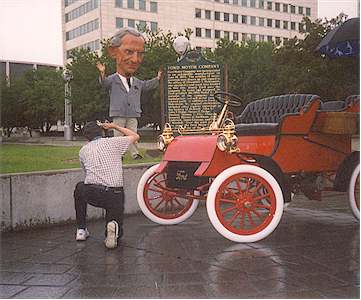 Now that Ford Motor Company was recognized as a successful automobile manufacturer, it was immediately pounced upon by the Association of Licensed Automobile Manufacturers who claimed that Ford Motor Company owed them a royalty on each automobile based on the patent granted to George H. Selden in 1895. Although 27 well-known auto manufacturers including Oldsmobile and Cadillac were paying a royalty on each car; it was Ford Motor Company that refused. Although the court battle lasted for eight years, Ford Motor Company finally won the case. It is often said that the early success of Ford Motor Company was due to the combination of James Couzens who could not assemble a Kiddy Kar, and Henry Ford who could not manage a grocery store. Together they had the talent needed to make a success of Ford Motor Company.
Now that Ford Motor Company was recognized as a successful automobile manufacturer, it was immediately pounced upon by the Association of Licensed Automobile Manufacturers who claimed that Ford Motor Company owed them a royalty on each automobile based on the patent granted to George H. Selden in 1895. Although 27 well-known auto manufacturers including Oldsmobile and Cadillac were paying a royalty on each car; it was Ford Motor Company that refused. Although the court battle lasted for eight years, Ford Motor Company finally won the case. It is often said that the early success of Ford Motor Company was due to the combination of James Couzens who could not assemble a Kiddy Kar, and Henry Ford who could not manage a grocery store. Together they had the talent needed to make a success of Ford Motor Company.
